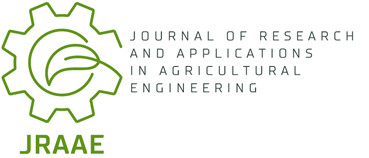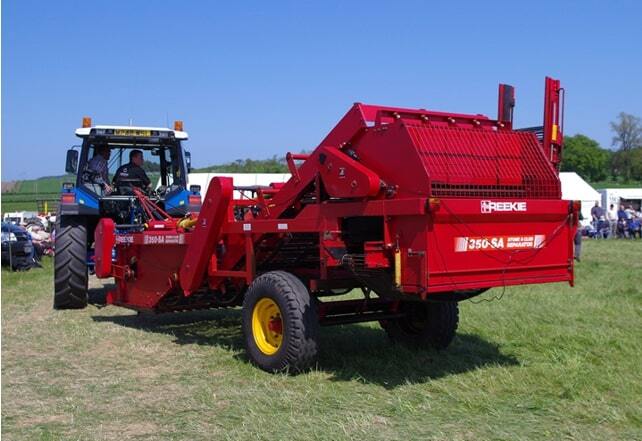Current issue
Online First
Archive
Instructions for Authors
Guide for Authors
Peer Review Policy
Research Ethics Policy
Ghostwriting and Guest Authorship
Copyright
Open Access Policy
Plagiarism
About the Journal
Aim and Scope
Scientific Board
Publisher
Editorial Board
Indexing in Databases
Personal Data Protection
Repository Policy
Contact
REVIEW PAPER
Hazards caused by stones in the arable layer of agricultural fields and methods for their removal
1
Centre for Modern Mobility, Łukasiewicz Research Network - Poznan Institute of Technology, Poland
2
Department of Biosystems Engineering, Poznań University of Life Sciences, Poland
Submission date: 2025-03-07
Final revision date: 2025-04-03
Acceptance date: 2025-04-11
Online publication date: 2025-04-17
Corresponding author
Florian Adamczyk
Centre for Modern Mobility, Łukasiewicz Research Network - Poznan Institute of Technology, E. Estkowskiego, 61-755, Poznań, Poland
Centre for Modern Mobility, Łukasiewicz Research Network - Poznan Institute of Technology, E. Estkowskiego, 61-755, Poznań, Poland
KEYWORDS
field stonesstone extractorstone scraperstone collectorscraper-collector machinedigger-collector machine
TOPICS
ABSTRACT
The current importance of using various methods of mechanical weed control. These methods are based on the action on the growing undesirable plants (weeds) in the soil of the working elements of tools carrying out mechanical weed elimination (knives, wide blades, chisels) used, for example, in weeders. Their direct contact with stones deposited in the cultivation layer of the field results in excessive, faster frictional wear or even destruction. Other machines at risk of damage from contact with stones are, for example, the cutting units of crop harvesting machines and the working units of combine harvesters for harvesting winter squash and sugar beet. The article identifies the hazards caused by stones in agricultural fields, related to hampering field work and worsening plant vegetation and harvesting conditions. Various stone removal methods are described and illustrated with technical examples. Spot removal of large stones and two-stage and one-stage harvesting from the entire field area are discussed. It was pointed out that the diverse range of machines available on the market makes it possible to fully mechanise the removal of stones, and that the high costs of such a procedure can be fully compensated by the removal of hazards to the working units of the machines and an increase in the quality of the crop.
REFERENCES (48)
1.
BN-78/9180-11. Soils and mineral formations. Division into fractions and granulometric groups. Industry stand-ard.
2.
Ryżak M., Bartmiński P, Bieganowski A. Methods for determination of particle size distribution of mineral soils. Ac-ta Agroph. 2009, 4(175), 1-84.
3.
PN-90/R-55003. Agricultural machinery. Research methods. Characteristics of operating conditions of field work machinery.
6.
Kamiński J.R., Szeptycki A., & Weremkowicz A. Principles of machine selection for technologies of stone removing from cultivated fields (Zasady doboru maszyn w technologiach usuwania kamieni z pól uprawnych). Problemy Inżynierii Rolniczej 2017, 4(98), 29-43.
7.
Toscano, P., Brambilla, M., Cutini, M. & Bisaglia, C. The Stony Soils Reclamation Systems in Agricultural Lands: A Review. Agricultural Sciences 2022, 13, 500-519. https://doi.org/10.4236/as.202....
8.
Butcher, B., Hinz, C. & Flühler, H. Sample Size for Determination of Coarse Fragment Content in a Stony Soil. Ge-oderma, 63, 1994, 265-275.https://doi.org/10.1016/0016-7....
9.
Corti, G., Ugolini, F.C. and Agnelli, & A. Classing the Soil Skeleton (Greater than Two Millimeters): Proposed Ap-proach and Procedure. Soil Science Society of America Journal 1998 62, 1620-1629. https://doi.org/10.2136/sssaj1....
10.
Miller, F.T. & Guthrie, R.L. Classification and distribution of soils containing rock fragments in the United States. In Erosion and Productivity of Soils Containing Rock Fragments, Soil Science Society of America, Nichols, J.D., Brown, P.L. and Grant, W.J., Eds.; Special Publication, Madison, US No. 13, 99. 1-6. https://doi.org/10.2136/sssasp....
12.
Colzani, G., Cammilli, A. & Pirrone, S. (1989) Stato Di Pietrosità Dei Terreni E Lavorazioni Agricole. L’Informatore Agrario, 42, 61-64.
13.
Mabbutt, J. (1965). Stone distribution in a stony tableland soil. Soil Research, 3, 131-142. https://doi.org/10.1071/SR9650....
14.
Nyssen, J., Poesen, J., Moeyersons, J., Lavrysen, E., Haile, M., & Deckers, J. (2002). Spatial distribution of rock frag-ments in cultivated soils in northern Ethiopia as affected by lateral and vertical displacement processes. Geo-morphology, 43, 1-16. https://doi.org/10.1016/S0169-....
15.
Kostencki, P., Stawicki, T., & Królicka, A. (2020). Wear of the working parts of agricultural tools in the context of the mass of chemical elements introduced into soil during its cultivation. International Soil and Water Conservation Re-search, 9, 229-240. https://doi.org/10.1016/j.iswc....
16.
Conrad, C., & Molnar, P. (1997). The growth of Rayleigh-Taylor-type instabilities in the lithosphere for various rheological and density structures, Geophysical Journal International, Volume 129, Issue 1, April 1997, Pages 95–112, https://doi.org/10.1111/j.1365....
17.
Pari, L., Giudice, A., Pochi, D., Gallucci, F., & Santangelo, E. (2016). An innovative flexible head for the harvesting of cardoon (Cynara cardunculus L.) in stony lands. Industrial Crops and Products, 94, 471-479. https://doi.org/10.1016/J.INDC....
18.
Li, C., Cao, X., & Sarker, B. (2021). Optimal Machine Stopping Time and Ordering Cycle for Parts to Minimize the Total Cost of a Supply Chain. IEEE Access, 9, 73286-73298. https://doi.org/10.1109/ACCESS....
19.
Val-Aguasca, J., Videgain-Marco, M., Martín‐Ramos, P., Vidal-Cortés, M., Boné-Garasa, A., & García-Ramos, F. (2019). Fire Risks Associated with Combine Harvesters: Analysis of Machinery Critical Points. Agronomy, 9, 877. https://doi.org/10.3390/agrono....
20.
Jankauskas, V., Abrutis, R., Žunda, A., & Gargasas, J. (2023). Wear Study of Straw Chopper Knives in Combine Harvesters. Applied Sciences. https://doi.org/10.3390/app131....
21.
Tomašková, M., Sobotová, L., & Matisková, D. (2019). Machinery Fire in Agriculture and its Impact on the Envi-ronment. 2019 International Council on Technologies of Environmental Protection (ICTEP), 254-257. https://doi.org/10.1109/ICTEP4....
22.
Soil Survey Staff, USDA (1999) Soil Taxonomy: A Basic System of Soil Classification for Making and Interpreting Soil Surveys. Agriculture Handbook, Second Edition, No. 436. https://www.nrcs.usda.gov/Inte....
23.
Tomašková, M., Matisková, D., & Baláziková, M. (2020). Case Study to Determine the Causes of Fire in Agriculture. Advances in Science, Technology and Engineering Systems Journal, 5, 11-15. https://doi.org/10.25046/aj050....
24.
Dorokhov, A., Aksenov, A., Sibirev, A., Mosyakov, M., Sazonov, N., & Godyaeva, M. (2023). Evaluation of Compar-ative Field Studies for Root and Onion Harvester with Variable Angle Conveyor. Agriculture. https://doi.org/10.3390/agricu....
25.
Sharma, R., Kumar, S., Chouhan, S., & Yadav, U. (2019). Design and Simulation of low cost Root Crop Harvester. Open Agriculture, 4, 139 - 143. https://doi.org/10.1515/opag-2....
26.
Hozhimatov, A. (2023). Analysis of destruction and protection of details of agricultural machinery. E3S Web of Con-ferences. https://doi.org/10.1051/e3scon....
27.
Gruczek T. Efektywność produkcji ziemniaka na glebach zakamienionych, (Efficiency of potato production on stony soils). Zeszyty Problemowe Postępów Nauk Rolniczych, 2002, z.489, 137-146.
28.
Kuczewski J., & Waszkiewicz C. Mechanizacja rolnictwa Tom II Maszyny i urządzenia do produkcji roślinnej i zwie-rzęcej. SGGW Warszawa 2007.
30.
Kamiński J., Lisowski A., Chlebowski J., Sypuła M., & Nowakowski T. Wyciągacze kamieni z pól uprawnych, (Rock diggers from farmlands). Technika Rolnicza Ogrodnicza Leśna 2017, 3 s. 25-28.
35.
Schulte Industries. https//www.schulte.ca/pl/produkt/srw-1400-windrower/. (accessed on 02 September 2024).
36.
Degelman Industries. https:/degelman.com/produkts/rock-removal/ rock-rake. (accessed on 02 September 2024).
37.
Schulte Industries. https//www.schulte.ca/pl/produkt/ rs-320-jumbo-rock-picker/. (accessed on 02 September 2024).
46.
Gage, J.E. Field Clearing: Field Clearing: Stone Removal and Disposal Practices in Agriculture & Farming with a Case Study of Stone Removal Activities in Joshua Hempstead’s Diary (2020 version). ASC Bulletin, 2020 ,76, 33-81. Version at Academia.edu https://www.academia.edu/43358... Revised & Expanded (June 12, 2020). (accessed on 02 September 2024).
We process personal data collected when visiting the website. The function of obtaining information about users and their behavior is carried out by voluntarily entered information in forms and saving cookies in end devices. Data, including cookies, are used to provide services, improve the user experience and to analyze the traffic in accordance with the Privacy policy. Data are also collected and processed by Google Analytics tool (more).
You can change cookies settings in your browser. Restricted use of cookies in the browser configuration may affect some functionalities of the website.
You can change cookies settings in your browser. Restricted use of cookies in the browser configuration may affect some functionalities of the website.



